Tropical Cyclone Report
Hurricane Felix
7 - 19 September 2001
Stacy R. Stewart
National Hurricane Center
30 November 2001
Felix was the second major hurricane (category 3 on the
Saffir-Simpson Hurricane Scale) of the season. It remained over the
open waters of the eastern Atlantic Ocean, but briefly threatened
the Azores Islands.
a. Synoptic History
Felix developed from a tropical wave and associated weak surface
low that crossed the African coast on 5 September. The wave and low
pressure area tracked westward for the next two days. On 6
September, QuikSCAT satellite wind data (not shown) indicated that
a surface circulation near the wave axis had become better defined.
Deep convection continued to increase and weak banding features
developed later that day as the system tracked a few hundred miles
south of the Cape Verde Islands. By early 7 September, QuikSCAT
satellite wind data and nearby ship observations indicated the low
pressure system had become better defined with westerly winds of 10
to 15 kt noted about 120 n mi southwest of the low-level center.
Deep convection became more centralized and banding features became
more pronounced in visible satellite imagery. Dvorak satellite
intensity estimates indicated the system had developed into
Tropical Depression Seven at 1200 UTC that same day about 360 n mi
southwest of the Cape Verde Islands. The "best track" chart of
Felix's path is given in Figure 1,
while the best track positions and
intensities are listed in Table 1. Wind and pressure plots are
shown in Figure 2 and Figure 3, respectively.
Tropical Depression Seven tracked rapidly westward between 18 to
20 kt for the next day or so. Despite the otherwise favorable
upper-level ridging across the system, the depression failed to
develop any further. It is surmised that the rapid westward motion
may have been associated with a low-level shear condition, which
resulted in the deep convection becoming displaced farther to the
east of the low-level center. Another possibility, based on
satellite water vapor and AMSU (Advanced Microwave Sounding Unit)
temperature data, is that the surrounding environment was more
stable than usual, which could also have been an inhibiting factor
to maintaining persistent deep convection near the center. By 1800
UTC on 8 September, convection became disorganized and QuikSCAT
surface wind data, plus a few ship reports, indicated that Tropical
Depression Seven had degenerated into a northeast-to-southwest
oriented open wave about 650 n mi west-southwest of the Cape Verde
Islands.
The wave tracked westward at around 15 kt for the next 36 hours.
An unfavorable vertical shear pattern developed across the system
when an upper-level trough amplified southward into the deep
tropics to the west of the wave. Eventually, the southwesterly
upper-level shear relaxed enough to allow for the redevelopment of
deep convection near the mid-level vorticity center late on 9
September. By 0600 UTC 10 September, conventional satellite data
suggested that a closed surface circulation had reformed and the
system became again Tropical Depression Seven. A QuikSCAT overpass
(data not shown) at 0816 UTC confirmed the existence of a broad
cyclonic circulation in the surface wind field.
Tropical Depression Seven tracked west-northwestward and
maintained a steady intensity of 30 kt for the next 24 hours. By
1200 UTC 11 September, the depression had acquired more convective
banding features and satellite intensity estimates indicated the
system had become Tropical Storm Felix.
The cyclone gradually turned northwestward and slowly
intensified, reaching hurricane strength around 0000 UTC on 13
September. Shortly after reaching hurricane status, Felix underwent
a period of rapid intensification (RI) in which the cyclone
strengthened 30 kt in an 18 h period. It is estimated that Felix
reached a peak intensity of 100 kt around 0000 UTC 14 September,
when it was situated about 1400 miles southwest of the Azores
Islands. It maintained that intensity until 0600 UTC, after which
it began to recurve to the northeast and gradually turned more
eastward ahead of an approaching mid-latitude trough.
Shortly after reaching its peak intensity, Felix began to weaken
at a slow but steady pace as upper-level westerly shear began to
increase. Late on 16 September, Felix turned northeastward and
began moving over much cooler water. The cyclone weakened to
tropical storm status at 1200 UTC 17 September, when it stalled
about 350 miles southwest of the Azores. Increasing upper-level
northwesterly shear and cold upwelling (as indicated by sea-surface
temperature reports from nearby buoys and ships) caused Felix to
weaken more rapidly as it drifted southward over its cold wake. It
weakened to a depression at 1800 UTC 18 September and dissipated at
0000 UTC on 19 September, when it was about 400 miles southwest of
the Azores Islands.
b. Meteorological Statistics
Observations in Felix (Figure 2 and Figure 3)
include satellite-based
Dvorak technique intensity estimates from the Tropical Analysis and
Forecast Branch (TAFB), the Satellite Analysis Branch (SAB) and the
U. S. Air Force Weather Agency (AFWA). Felix's peak intensity of
100 kt at 0000 and 0600 UTC on 14 September is based on a Dvorak
satellite classification of 102 kt (T5.5) from the TAFB.
The period of rapid intensification that occurred is not unusual
for a tropical cyclone that moves through a weakness in the
subtropical ridge. Once on or just north of the ridge axis, the
upper-level shear is usually at a minimum, which allows for the
inner-core circulations to become more vertically aligned.
Figure 4 and Figure 5
are 85 GHz microwave satellite images of Felix obtained
from the Defense Meteorological Satellite Program (DMSP). The
images clearly show a significant change in the inner-core region,
as well as the outer banding features, during the 21 h period
between the two images. As often is the case during RI periods, the
eye diameter of Felix at the end of the RI cycle had contracted
down to nearly half its original size. It also worth noting that
the first indication of an eye in the microwave data became evident
several hours before it appeared in conventional satellite imagery
(data not shown).
Ship reports of tropical storm force winds associated with Felix
are given in Table 2. Pressure reports from drifting buoys 41644
and 44765 were critical in determining the strength of Felix since
satellite intensity estimates became less reliable once the cyclone
began to lose its central deep convection and overall convective
organization.
There were no reports of tropical storm force winds in the
Azores Islands because Felix rapidly weakened and eventually turned
southwestward away from the islands.
c. Casualty and Damage Statistics
No reports of damage or casualties associated with Hurricane
Felix were received by the National Hurricane Center.
d. Forecast and Warning Critique
Average official track errors (with the number of cases in
parentheses) for Felix were 33 (27), 57 (25), 72 (23), 90
(21), and 142 (17) n mi for the 12, 24, 36, 48, and 72 h forecasts,
respectively. These
errors are much better than the previous 10-year averages,
especially in the 24-72 h time periods. (Table 3). The Aviation
(AVNI) model was the only forecast guidance to outperform the
official forecast throughout 72 h forecast period..
The average intensity errors were similar to the
long-term averages through 48h, but were significantly better at 72
h. The average official intensity errors were 6, 11, 14, 15, and 16
kt for the 12, 24, 36, 48, and 72 h forecasts, respectively. For
comparison, the average official intensity errors over the 10-yr
period 1991-2000 are 7, 11, 14, 16, and 20 kt, respectively. The
SHIPS intensity forecast model had errors similar the official
forecast. The GFDI performed slightly better through 36 h, but was
worse at 48 and 72 h. The AVNI intensity forecasts were
significantly worse (almost double) than the official and SHIPS
forecasts at all time periods.
No watches or warnings were required for
Hurricane Felix.
Table 1: Best track for Hurricane Felix, 7 - 19 September 2001.
Date/Time
(UTC) | Position | Pressure
(mb) | Wind Speed
(kt) | Stage |
| Lat. (°N) | Lon. (°W) |
| 07 / 1800 | 13.9 | 28.4 | 1008 | 30 | tropical depression |
| 08 / 0000 | 14.4 | 29.5 | 1007 | 30 | " |
| 08 / 0600 | 14.8 | 31.0 | 1007 | 30 | " |
| 08 / 1200 | 15.0 | 33.0 | 1008 | 30 | " |
| 08 / 1800 | 15.0 | 35.1 | 1009 | 25 | tropical wave |
| 09 / 0000 | 15.0 | 37.0 | 1009 | 25 | " |
| 09 / 0600 | 15.0 | 38.7 | 1009 | 25 | " |
| 09 / 1200 | 15.0 | 40.2 | 1009 | 25 | " |
| 09 / 1800 | 15.0 | 41.7 | 1009 | 25 | " |
| 10 / 0000 | 15.2 | 43.1 | 1009 | 25 | " |
| 10 / 0600 | 16.0 | 43.7 | 1008 | 30 | tropical depression |
| 10 / 1200 | 16.5 | 44.8 | 1008 | 30 | " |
| 10 / 1800 | 16.9 | 45.8 | 1007 | 30 | " |
| 11 / 0000 | 17.3 | 46.8 | 1006 | 30 | " |
| 11 / 0600 | 17.8 | 47.4 | 1004 | 30 | " |
| 11 / 1200 | 18.6 | 47.7 | 1003 | 35 | tropical storm |
| 11 / 1800 | 19.4 | 48.0 | 1003 | 35 | " |
| 12 / 0000 | 20.2 | 48.4 | 1000 | 40 | " |
| 12 / 0600 | 21.0 | 48.8 | 998 | 45 | " |
| 12 / 1200 | 22.0 | 48.9 | 994 | 55 | " |
| 12 / 1800 | 22.9 | 49.0 | 993 | 60 | " |
| 13 / 0000 | 23.9 | 48.9 | 987 | 65 | hurricane |
| 13 / 0600 | 24.8 | 48.6 | 979 | 75 | " |
| 13 / 1200 | 25.9 | 48.4 | 972 | 85 | " |
| 13 / 1800 | 27.1 | 48.0 | 966 | 95 | " |
| 14 / 0000 | 28.2 | 47.2 | 962 | 100 | " |
| 14 / 0600 | 29.3 | 46.6 | 962 | 100 | " |
| 14 / 1200 | 30.1 | 45.5 | 966 | 95 | " |
| 14 / 1800 | 30.9 | 44.3 | 970 | 90 | " |
| 15 / 0000 | 31.2 | 42.8 | 970 | 90 | " |
| 15 / 0600 | 31.5 | 41.4 | 970 | 90 | " |
| 15 / 1200 | 31.7 | 39.5 | 970 | 90 | " |
| 15 / 1800 | 32.1 | 37.6 | 975 | 85 | " |
| 16 / 0000 | 32.1 | 36.0 | 975 | 85 | " |
| 16 / 0600 | 32.6 | 34.8 | 976 | 80 | " |
| 16 / 1200 | 33.4 | 33.3 | 977 | 75 | " |
| 16 / 1800 | 34.3 | 32.4 | 979 | 70 | " |
| 17 / 0000 | 35.1 | 32.0 | 981 | 70 | " |
| 17 / 0600 | 35.4 | 31.7 | 983 | 65 | " |
| 17 / 1200 | 35.3 | 31.5 | 985 | 60 | tropical storm |
| 17 / 1800 | 35.2 | 31.8 | 990 | 55 | " |
| 18 / 0000 | 35.0 | 32.0 | 995 | 45 | " |
| 18 / 0600 | 34.8 | 32.0 | 998 | 40 | " |
| 18 / 1200 | 34.7 | 31.9 | 1001 | 35 | " |
| 18 / 1800 | 34.7 | 31.7 | 1002 | 30 | tropical depression |
| 19 / 0000 | 34.6 | 31.6 | 1002 | 25 | " |
| 19 / 0600 | | | | | dissipated |
| 14 / 0000 | 28.2 | 47.2 | 962 | 100 | minimum pressure |
| 14 / 0600 | 29.3 | 46.6 | 962 | 100 | " |
Table 2: Selected ship observations of tropical storm or greater
winds associated with Hurricane Felix, 7 - 19 September 2001.
| Ship Name or Call Sign | Date/Time (UTC) | Lat. (°N) | Lon. (°W) | Wind dir/speed (deg/kt) | Pressure (mb) |
| ELSW5 | 13 / 1200 | 27.5 | 45.8 | 120 / 33 | 1011.0 |
| KAKG | 16 / 1800 | 36.4 | 32.2 | 090 / 35 | 1000.5 |
| C6PW2 | 17 / 1200 | 37.5 | 33.8 | 040 / 34 | 1008.0 |
|
Table 3: Preliminary track forecast evaluation for Hurricane Felix - heterogeneous sample. Errors in nautical miles for
tropical storm and hurricane stages with number of forecasts in
parentheses. Bold numbers represent forecasts which were
better than the official forecast.
| Forecast Technique | Period (hours) |
| 12 | 24 | 36 | 48 | 72 |
| CLIP | 51 (27) | 122 (25) | 200 (23) | 267 (21) | 454 (17) |
| GFDI | 29 (27) | 58 (25) | 85 (23) | 120 (21) | 219 (17) |
| LBAR | 34 (27) | 63 (25) | 89 (23) | 114 (21) | 187 (17) |
| AVNI | 29 (27) | 44 (25) | 61 (23) | 89 (21) | 129 (17) |
| BAMD | 52 (27) | 96 (25) | 137 (23) | 169 (21) | 231 (17) |
| BAMM | 43 (27) | 87 (25) | 126 (23) | 162 (21) | 228 (17) |
| BAMS | 47 (27) | 89 (25) | 127 (23) | 173 (21) | 280 (17) |
| NGPI | 36 (27) | 69 (25) | 103 (23) | 134 (21) | 194 (17) |
| UKMI | 38 (27) | 73 (25) | 98 (23) | 108 (21) | 137 (17) |
| GUNS | 30 (27) | 61 (25) | 89 (23) | 110 (21) | 150 (17) |
| NHC Official | 33 (27) | 57 (25) | 72 (23) | 90 (21) | 142 (17) |
| NHC Official (1991-2000 mean) | 44 (2049) | 82 (1835) | 118 (1646) | 151 (1475) | 226 (1187) |
| *Output from these models was unavailable at time of forecast issuance. |
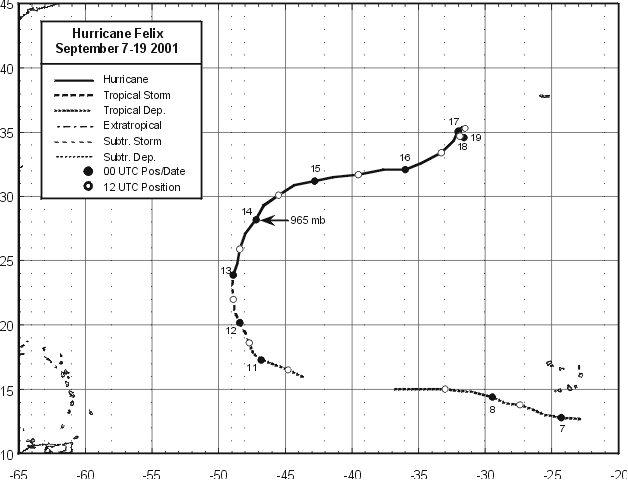
Figure 1:
Best track positions for Hurricane Felix, 7-19 September 2001.
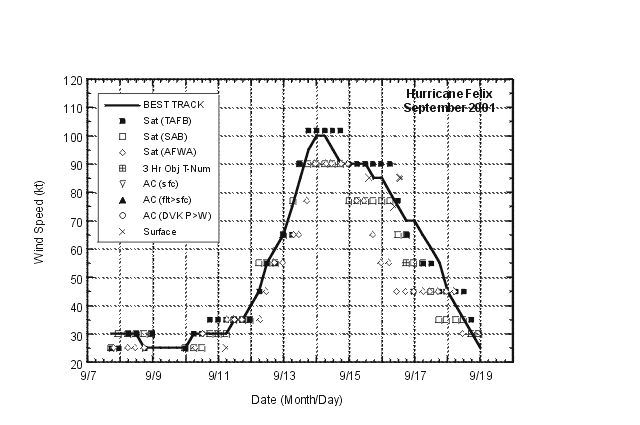
Figure 2:
Best track maximum sustained surface wind speed curve for
Hurricane Felix, 7-19 September 2001, and the observations on which the best
track curve is based.
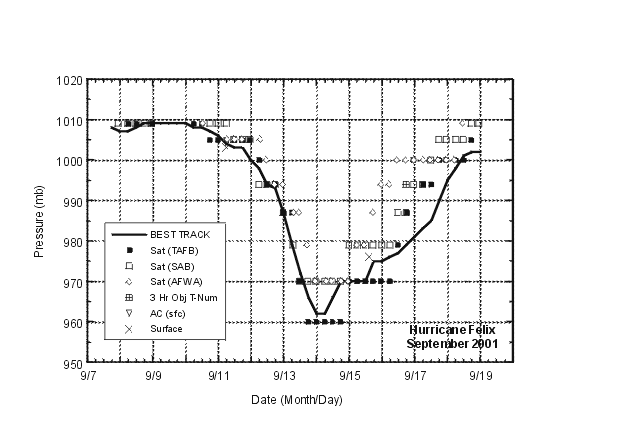
Figure 3:
Best track minimum central pressure curve for Hurricane Felix,
7-19 September 2001, and the observations on which the best track curve is
based.
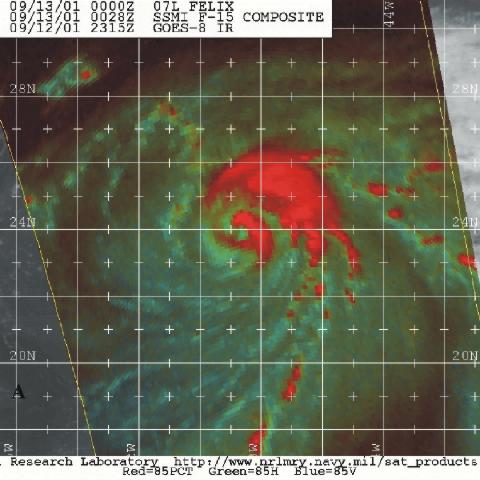
Figure 4:
Microwave satellite imagery (85 GHZ) from the DMSP Special Sensor
Microwave Imager (SSMI). At 0028 UTC 13 September (Figure 4), an eye is
clearly defined near 24N 48.5W when Felix was at 65 kt and beginning a
period of rapid intensification.
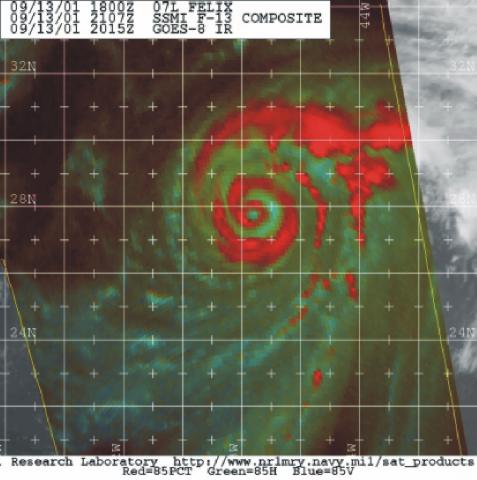
Figure 5:
Microwave satellite imagery (85 GHZ) from the DMSP Special Sensor
Microwave Imager (SSMI). By 2107 UTC, Felix had
completed the RI cycle and was near 95 kt. Note the significant change in
the eye and the banding structure during the 21 h period. Felix reached its
intensity a few hours after the image time in Figure 5. It is important to
note that an eye did not become evident in conventional infrared imagery
until 0645 UTC when the first image became available after a 3 h satellite
eclipse period. Even then, the eye was only weakly apparent and did not
become clearly defined until 1115 UTC.
|
![[NCEP Logo]](https://webarchive.library.unt.edu/eot2008/20080916171702im_/http://www.nhc.noaa.gov/graphics/ncep.gif)




